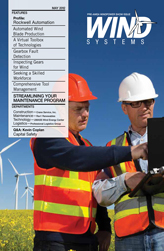Armed with some experience and a bit of awareness, there are several ways in which a technician can diagnose wind turbine gearbox problems while uptower. Using the physical senses, it becomes relatively straightforward to listen for noises coming from the gearbox, to observe surface damage on the gearing, and to observe the color and smell of the oil. A technician conducting routine maintenance is a first responder and has the ability to evaluate the operating condition of the gearbox through some very simple techniques, even without the use of a borescope or vibration monitoring system.
In conducting end of warranty inspections, we typically find a number of turbine gearboxes with internal gear damage that occurred over a relatively short period of time. While these issues have materialized largely unnoticed by the project owner up to the final turnover inspection, the effect of such irreversible conditions will gravely impact the performance of the gearbox through future years. Proper lubrication and control of contaminants has never been more important both during and after the warranty period. It is expressly the technician’s responsibility to avoid contamination during the maintenance of the gearbox, and while contamination can enter gearboxes in a number of ways, you can be assured that whenever the gearbox is opened for inspection, top-off, or repair, a significant opportunity exists for contaminant ingress.
Even though an operating turbine’s gearbox might sound normal from the ground, it could be in quite different shape once the inspection covers are pulled and an oil sample is taken. Finding damage—witness marks, in particular—on high-speed gearing can be an indication that a softer-material, slower-moving component is fragmenting and sending metal particulates into the oil system.
We sometimes see gearing surface damage immediately upon pulling covers and then locate the actual source of the contaminant as being a planetary gear or bearing that has progressively failed. Spall, flaking, polishing, fractures, witness marks, and to some degree macro-pitting can all be observed with the naked eye. While these each have different initiators, the technician should be able to assess the severity of the damage and link it to other physical factors during an inspection.
There are some important observations that should be made when an oil sample is taken on a wind turbine gearbox. Odor, color, presence of froth, and sediment fallout tell us several things about the health of the gearbox even before we begin a thorough inspection of the internals. Of course, one needs to start with a clean, clear bottle—it would make little sense to miss an opportunity to immediately observe important oil properties such as color and brightness when your task is to conduct a thorough gearbox inspection.
Sample bottles are available in several materials, and one of the more common types is plastic polyethylene; an opaque material like that of a milk jug. Rather, a project operator focused on uptower diagnosis should always use PET plastic bottles, those that are completely clear and allow for the oil sample to be visually examined upon being taken. This plastic material is compatible with most types of lubricating oils and hydraulic fluids, including synthetics.
The physical properties of gearbox oil—sediment, darkness, brightness, clarity, and color—can be immediately learned from a visual inspection. A sour smell can indicate contamination or excessive degradation. Unusual darkening or solids entrapped in the oil can mean internal contamination. After shaking the sample vigorously, the foam should dissipate from the surface within 10 minutes and air bubbles should disappear in about 15 minutes. If not, this might indicate degradation of the oil’s additives. After a rest period the oil should be transparent, and if you’re unable to read the print on the cover of this magazine through a clear sample, it is likely an indication that water is emulsified in the oil. We will continue our discussion in the June issue of Wind Systems magazine.



































